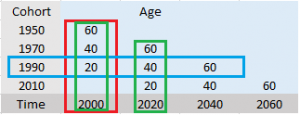Experimental Design > Cross Sequential Design
Cross sequential design (sometimes called a cross-sectional sequence) is a mix between cross sectional research and longitudinal research.
The design begins as a cross sectional design; data is collected at one specific point in time on two or more groups. A follow up is conducted on the groups two or more times, which gives the cross-sectional its longitudinal aspect (Mitchell et. al, 2012; Burney & White, 2009).

A longitudinal study would take one cohort (e.g. people born in 1990) and study it over a period of time. A cross sectional study would study a variety of age groups (say, those born in the ’50s, ’70s, and ’90s) in one year. To achieve a cross sequential design, you basically perform one cross sectional design, then repeat the observation at a later time period (the longitudinal part of the study).
Advantages and Disadvantages of the Cross Sequential Design
On major advantage of cross sequential designs is to correct the low internal validity that the cross sectional and longitudinal designs are known for. By conducting cross sequential research, you can avoid mistaking normative history-graded influences or cohort effects for age graded influences (i.e. age effects) (Mitchell & Jolley, 1998).
However, the method isn’t without its disadvantages. Differences in age are confounded with interactions between the cohort and when the measurement was taken. For example, older cohorts (e.g. Generation Xers) would give “age” estimates that happened before major historical events like 9/11. Younger cohorts (e.g. Generation Yers) would give these estimates after the historical events had happened (Little, 2013).
References
Burney, D. & White, T. (2009). Research Methods. Cengage Learning.
Mitchell, M. & Jolley, M. (1988). Research Designs Explained. 1st Ed. Holt, Rinehart & Winston.
Little, T. (2013). Longitudinal Structural Equation Modeling. Guilford Press.
Mitchell et. al (2012). Writing for Psychology. Cengage Learning.
Woolf, L. (1998). Theoretical Perspectives Relevant to Developmental Psychology. Retrieved November 16, 2017 from: http://faculty.webster.edu/woolflm/designs.html